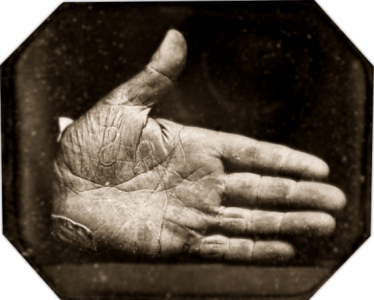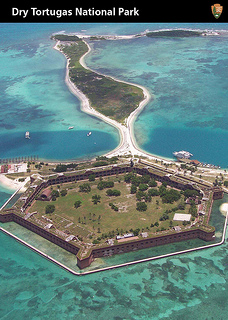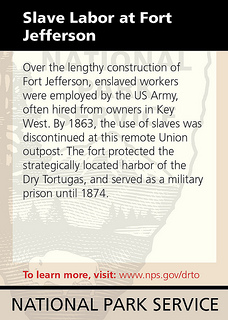
Ranger develops ‘freedom on bay’ project
As a park ranger for Biscayne National Park, Gary Bremen has several duties.
His primary role is informing the public about all aspects of the park. When he takes groups on tours he tells them about the history of the park, the attractions they could see and information about the wildlife within it.
There’s one thing that Bremen does, though, that’s outside of his regular duties, but well inside his interests. He has dedicated part of his time to finding connections between the lands located in the park and around South Florida to historical events, dating back to the Civil War.
 |
At left, the branded hand of Captain Jonathan Walker (Photo courtesy of The Massachusetts Historical Society). Next, the front of the trading card for Dry Tortugas National Park in the Civil War to Civil Rights program (Photo courtesy of the National Park Service). |
Bremen calls this project “Finding Freedom on Biscayne Bay,” a look into the role the land has played from when this country was first established, in the Underground Railroad, all the way to modern day cases of refugees fighting their way to the Florida shores.
“It is a loose association of historic events of people looking for freedom,” he said.
He explained that he first became interested in this idea by hearing stories of the Underground Railroad in Florida. After he became a park ranger, he started making more of these connections as he heard of stories of people coming through the state to gain their liberty, during the Civil War.
“It’s the kind of history that people don’t know about,” Bremen said.
According to Dr. Roslyn Howard, professor of anthropology and the director of the North American Indian Studies Program at the University of Central Florida, during the time that the Spanish had control of Florida they actively tried getting enslaved African-Americans to escape to the southernmost territory of the continent, promising them freedom in exchange for converting to Catholicism.
 However, after the ownership of the peninsula passed hands a few times, from Spain to Britain, back to Spain again and finally was annexed by the U.S. in 1821, Howard said, the blacks, whom she prefers to call “freedom fighters” instead of slaves or former slaves, knew that they would have to either leave to Indian country with the Seminoles, which was in Oklahoma, or flee.
However, after the ownership of the peninsula passed hands a few times, from Spain to Britain, back to Spain again and finally was annexed by the U.S. in 1821, Howard said, the blacks, whom she prefers to call “freedom fighters” instead of slaves or former slaves, knew that they would have to either leave to Indian country with the Seminoles, which was in Oklahoma, or flee.
“Key Biscayne was a key place for those who decided to flee to the swamps,” she said. “They fled to the Bahamas from Cape Florida.”
These are the type of stories that Bremen is searching for — accounts of people either using Florida as a means to reach freedom, or finding their freedom here.
Another story from the Civil War period that he was very excited about because he had recently made the connection was that of Capt. Jonathan Walker who was caught smuggling seven slaves within Cape Florida in 1845.
His hand was branded with the letters “SS” for “slave stealer,” though the people in the north preferred the term “slave savior.” After hearing the story he realized that it could have very likely have happened in Biscayne waters.
“There hasn’t been a direct connection between Biscayne National Park and the Underground Railroad before,” Bremen said. “But, I’m much closer than I’ve ever been to making that connection. And being that close to the story makes the hairs on the back of my neck stand up.”
The stories for Finding Freedom on Biscayne Bay cover a whole breadth of experiences, not just enslaved people trying to flee to freedom.
For example, there are stories from the 1930s of Chinese people being smuggled through Elliott Key.
The people who built homes out in Stiltsville were in search of some kind of freedom, away from everything else, Bremen said.
“There are lots of people who are trying to get away from life as it was for them,” he said.
And of course, in those experiences would also be included the most relevant to today of Cuban and Haitian refugees braving the waters to make it to American soil. Bremen said that they still find rafts and home-made boats out in the shores of Biscayne National Park.
His idea for the project goes beyond just gathering stories, though. Next fall there will be an art exhibit by the same name as the project. Paintings by Shannon Crowell, a Florida wildlife artist, depicting some of the places in Biscayne National Park that are relevant to the stories will be displayed. This is the first iteration of Finding Freedom on Biscayne Bay, Bremen said.
The second, he said he hopes will be collaboration with another National Park Service project called from Civil War to Civil Rights. This project began in the northeast region of the service by a team of interpreters in honor of the upcoming 150th anniversary of the end of the Civil War. The group came up with the idea of creating trading cards of events, people and places important to that period to be given out at the parks where they happened or where they are commemorated.
“It’s based on social science that people will remember better if they have a memento from an experience,” said Joanne Blacoe, an interpretive planner in the Northeast Regional Office and part of the team that began the project.
She said the main motivation for the project was to get these stories into the mainstream, a concept that goes hand in hand with Bremen’s idea. Cards for Biscayne National Park will be made by him based on the stories he’s collected, expanding the reach of the project that already covers 89 parks, or 22 percent of the entire national parks system, and connecting this region to all the others.
 |
The back of the card describes a part of history that took place in the park (Photo courtesy of the National Park Service) |
“This helps Americans see the full breadth of what’s in their national parks,” Blacoe said.
Bremen said that it is his job as a park ranger to find ways to create interest in the park, and he sees this project as a new way for the diversifying population to connect not just to these sites, but also to human history.
“There are concepts that many people can relate to which are struggle, love and religion,” he said. “If there is a connection to something bigger it makes it relevant to some people.”
If You Go
- Biscayne National Park, 9700 SW 328th St., Homestead, Fla.
- To get to Convoy Point, where the Dante Fascell Visitor Center is located: From the North: From the Florida Turnpike: Take the Florida Turnpike south, to Exit 6 (Speedway Blvd.). Turn left from exit ramp and continue south to SW 328th Street (North Canal Drive). Turn left and continue to the end of the road. It is approximately five miles, and the entrance is on the left. Or you can also take U.S. 1: Drive south to Homestead. Turn left on SW 328th Street (North Canal Drive), and continue to the end of the road. It is approximately nine miles, and the entrance is on the left.From the South: Traveling on U.S. 1 (Overseas Highway), drive north to Homestead. Turn right on SW 328th Street (North Canal Drive — first light after Florida Turnpike entrance), and continue to the end of the road. The entrance is approximately nine miles on the left.
- Convoy Point is open daily from 7 a.m. to 5:30 p.m.
- The Fascell Visitor Center is open daily from 9 a.m. to 5 p.m.
- The water portion of the park is open 24 hours a day. Adams Key, which is only accessible by boat is a day use area only.
- Elliott Key is only accessible by boat. Visitors can take their own boat and pay a $20 a night docking fee which includes the use of one campsite for up to six people and two tents.
- For transportation to the island, visit the concessioner’s website at http://www.BiscayneUnderwater.com or call 305-230-1100. There is a $15 per night fee for camping.

Comments are Closed